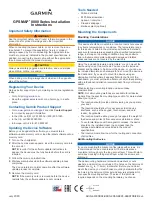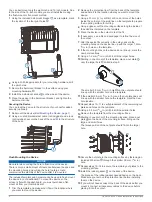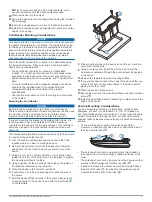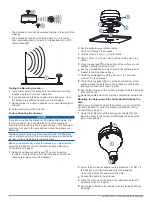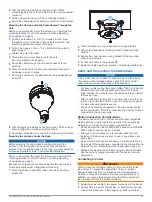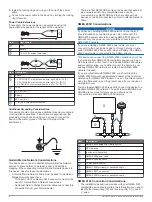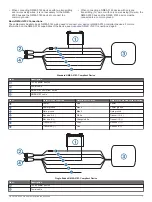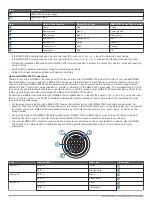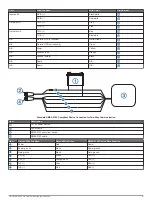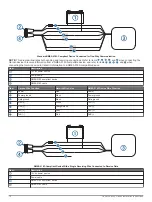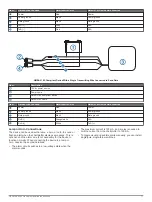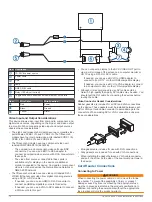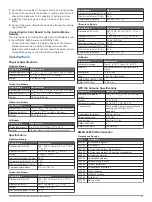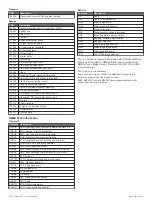
• The antenna should not be mounted directly in the path of the
radar .
• The antenna should be mounted at least 1 m (3 ft.) away
from (preferably above) the path of a radar beam or a VHF
radio antenna .
Testing the Mounting Location
1
Temporarily secure the antenna in the preferred mounting
location and test it for correct operation.
2
If you experience interference with other electronics, move
the antenna to a different location, and test it again.
3
Repeat steps 1–2 until you observe full or acceptable signal
strength.
4
Permanently mount the antenna.
Surface Mounting the Antenna
NOTICE
If you are mounting the bracket on fiberglass with screws, it is
recommended to use a countersink bit to drill a clearance
counterbore through only the top gel-coat layer. This will help to
avoid any cracking in the gel-coat layer when the screws are
tightened.
Stainless-steel screws may bind when screwed into fiberglass
and overtightened. Garmin recommends applying an anti-seize
lubricant to the screws before installing them.
Before you permanently mount the antenna, you must test the
mounting location for correct operation (
1
Using the surface-mount bracket as your mounting
template, mark the three pilot-hole locations and trace the
cable-hole in the center of the bracket.
2
Set the surface-mount bracket aside.
Do not drill through the bracket.
3
Drill the three 3.2 mm (
1
/
8
in.) pilot holes.
4
Use a 25 mm (1 in.) hole saw to cut the cable hole in the
center.
5
Place the seal pad on the bottom of the surface-mount
bracket, aligning the screw holes.
6
Use the included M4 screws to secure the surface-mount
bracket to the mounting surface.
7
Route the cable through the 25 mm (1 in.) hole and
connect it to the antenna.
8
Verify the large gasket is in place on the bottom of the
antenna, place the antenna on the surface-mount bracket,
and twist it clockwise to lock it in place.
9
Secure the antenna to the mounting bracket with the included
M3 set screw .
10
Route the cable away from sources of electronic interference.
Mounting the Antenna with the Cable Routed Outside the
Pole
Before you permanently mount the antenna, you must test the
mounting location for correct operation (
).
1
Route the cable through the pole-mount adapter , and
place the cable in the vertical slot along the base of the
pole-mount adapter.
2
Screw the pole-mount adapter onto a standard 1 in. OD, 14
threads per inch, pipe-threaded pole (not included).
Do not overtighten the adapter on the pole.
3
Connect the cable to the antenna.
4
Place the antenna on the pole-mount adapter and twist it
clockwise to lock it in place.
5
Secure the antenna to the adapter with the included M3 set
screw .
4
GPSMAP 8000 Series Installation Instructions

